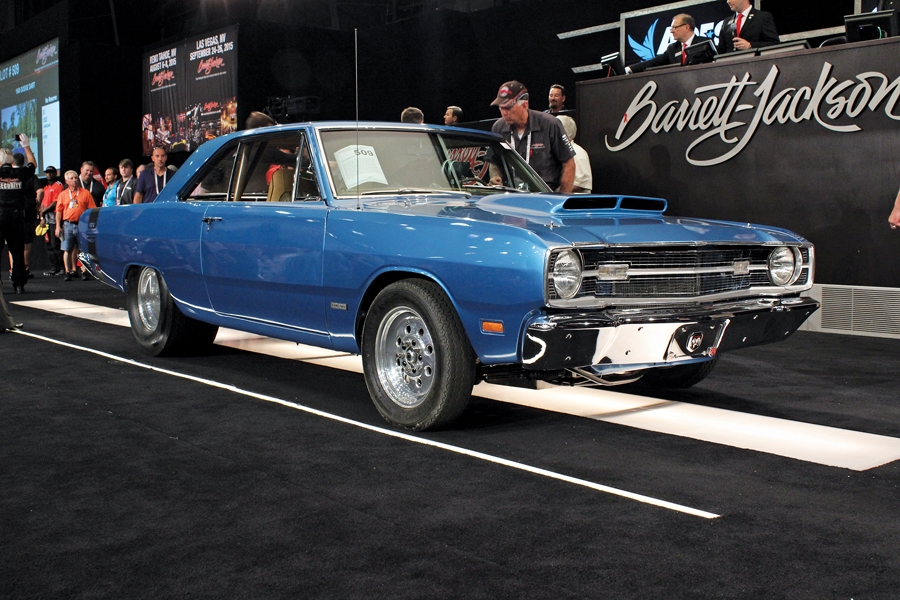Upgraded with a Mopar 478-cubic-inch Hemi engine using twin Holley 4-barrel carburetors on a cross ram intake manifold. Tubular headers, MSD ignition and a host of other performance tweaks are included.
The car features Wilwood front disc brakes and rear drum brakes, following the Hemi Dart theme. The Dart’s clean economical lines are nicely finished in PPG Metallic Blue paint. A straightforward approach is taken with a tan interior and multi-point roll cage, tan carpet and ’Cuda bucket seats mated with Hurst pistol-grip shifter and a woodgrain steering wheel.
SCM Analysis
Detailing
This car, Lot 509, sold for $43,450, including buyer’s premium, at Barrett-Jackson’s sale in Palm Beach, FL, on April 17–19, 2015.
The Dodge Dart was given an all-new look in 1967, and the result was a classic design that continued in production with basic cosmetic changes until 1976.
In addition to being one of Chrysler’s best-selling cars of the era, the Dart had a huge impact in the drag race and street performance car world. The basic 340 Swinger was one of the best budget small-block screamers ever made, and the limited-edition 383 and 440 big-block GTS soothed those with the cubic-inch fever.
The Dart goes racing
For the NHRA competition realm, the 1968 Hemi Dart was the weapon of choice by racers from Charlie Castaldo to Arlen Vanke. As delivered from the factory, the LO23 Super Stock Hemi Dart was a serious speed tool. Niceties were few: There was no radio or heater. Your seat was a Dodge van special with aluminum brackets. But you did get a gorilla of an engine — a 426 Hemi with 12.5-to-one pistons, dual Holley 4-barrels, Hooker headers, and your choice of automatic 727 or a 4-speed manual.
The package was capable of running deep into the 10s from the showroom floor — fast enough to walk away from just about anything else being built by the Big Three at the time.
Surviving Hemi Darts are highly desirable to racers seeking a genuine unit for competition, and to collectors of vintage race cars. But real ones are highly valued by their owners, and that means that for the most part, they aren’t cruise-night candidates. So what does the Mopar enthusiast who just has to have a Hemi Dart — one of the baddest American cars ever built — do? That’s where cars like this custom build start to shine.
Building your own
This 1969 Hemi Dart pays homage to Mopar’s race heritage and brings it forward using a modern iteration of the Hemi in combination with advances in brake, cam and valve-train technology. In the simplest terms, this is a modernized, usable version of the Hemi Dart using the basic Hemi-in-a-small-car formula. And while it may not be as mean as an original, it will be easier to use, if only for the simple fact that it’s not rare.
On top of that, instead of being a bare-bones racing crate, this car also has a nicely upholstered tan vinyl interior with upscale ’Cuda bucket seats from a Gran coupe — the ones with the buddy fold-down armrest. Lush tan carpeting and floor mats compliment the door panels. Even the headliner is fabric and the roll cage is color coordinated to match.
Overall, the craftsmanship on this car appears to be pretty high. A look at the engine bay reveals a better level of paint finish quality than Mopar performed on their show vehicles. Name-brand parts were used throughout. The custom fabricated bits such as the solid engine mounts are nicely detailed pieces you’d be proud to show off at the burger stand. All this stuff took time to make and to install professionally.
Priced right
Buying an original Hemi Dart is an expensive proposition — the most recent ACC Pocket Price Guide puts prices for the original 80 Super Stock Hemi cars at $125,000 to $165,000. If the car in question has a good race history or a driver’s name attached to it, the price rises. The model is so competitive that NHRA still keeps a class open for them under SS/AH, where racers still set records with engine combos pushing 1,000 horsepower. Even the VIN tags alone are worth a lot of money.
You can hardly lump an original and a replica like this into the same basic category — their uses and their target buyers are very different. But buying a car like this, built with some of the same looks, makes a lot of sense for an end user who wants something with some of that same bad-boy LO23 attitude while being a lot more usable. And it makes even more sense to buy one already done, as it’ll almost always be cheaper than building one yourself.
You can break it down like this: A Mopar 478-ci Hemi crate-engine long block runs about $16,000 and change. Completing one so it can run pushes your build total to the halfway mark on the winning bid seen here — and we haven’t touched the body, interior, paint and extras it would take to duplicate this package. In terms of bang for the buck, this thing rates pretty high on the scale.
Considering all that, if this car runs as good as it looks, the owner made a smoking burnout of a deal at $43k. Any way you look at it, this is excellent value for the money. Well bought.
(Introductory description courtesy of Barrett-Jackson.
